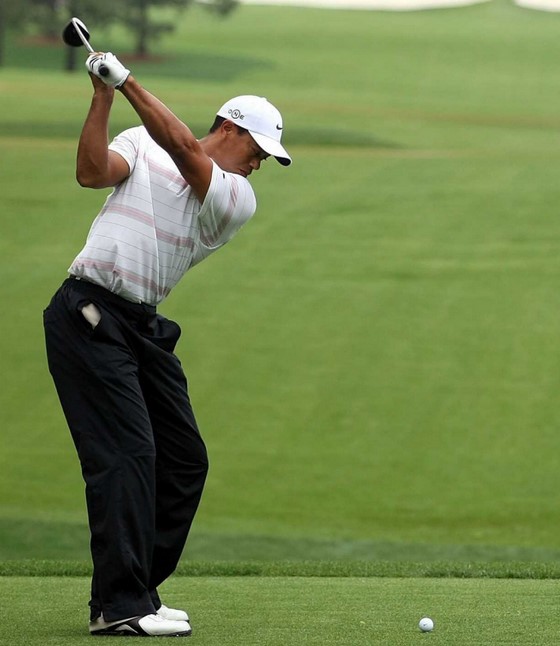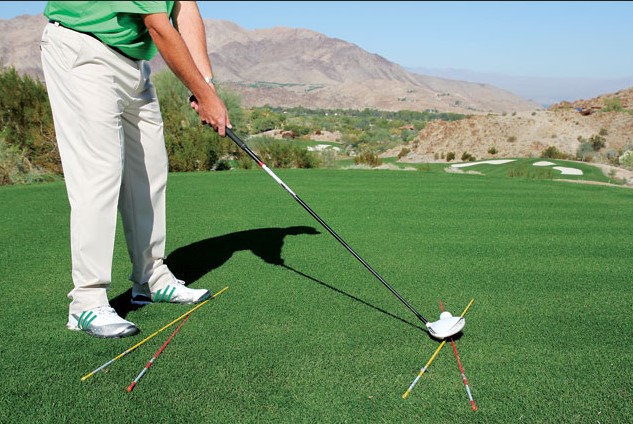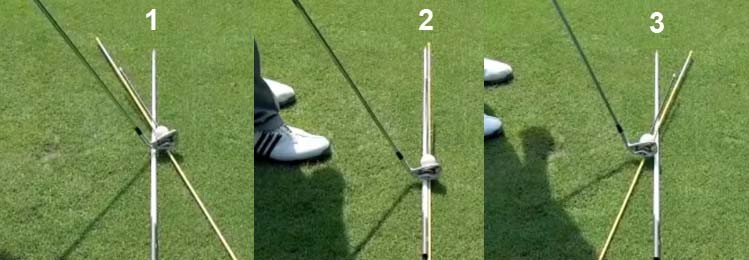Golf is far more than just swinging a club and hitting a ball. It is a sport that demands intense concentration, precise control, and a deep understanding of technical fundamentals. One of the most common yet challenging skills for players of all levels is producing a consistently straight and accurate shot. While the concept may seem simple, achieving a straight golf shot is one of the most technically demanding elements in the game, influenced by everything from body posture to swing mechanics.
Mastering the technique of hitting straight shots is critical, as it can significantly impact your performance and final score. From tee-off to approach shots near the green, hitting straight can be the difference between a birdie, par, or bogey. Below, GoGolf outlines the comprehensive steps and proven techniques to help you develop and refine straight golf shots with precision.
1. Adjust Your Body Posture for Optimal Setup
The first step in hitting a straight shot is to establish a proper and balanced setup. Your posture isn’t just about comfort—it’s a critical component that affects your swing path and overall consistency. A poor posture often leads to unstable swings, resulting in off-target shots.
Start by standing upright yet relaxed. Position your feet slightly wider than shoulder-width apart to create a strong, stable foundation. Feet placed too close together can disrupt balance during the swing, while overly wide feet can restrict hip rotation. Your knees should be naturally flexed, not locked, to allow fluid motion and energy transfer.
Lean forward from your hips—not your back—to maintain a straight spine and avoid tension that could impair shot accuracy. Let your arms hang naturally, with your hands positioned directly beneath your chin. For driver shots, ensure the ball is aligned with the midpoint between your feet.
A balanced posture promotes even weight distribution and gives your body the space needed for a full, unrestricted swing. With the correct stance, you’ll generate a smooth rotation of the hips and shoulders, leading to a more consistent and accurate swing path.
Make golf booking effortless. Install GoGolf App now!

2. Maintain Balance Throughout the Entire Swing
Balance is key to every phase of the golf swing—from backswing and downswing to follow-through. It directly influences the stability, power, and direction of your shots.
Begin by distributing your weight evenly between both feet. As you take the club back in the backswing, allow your weight to shift gradually onto your back foot (right foot for right-handed players). This shift must be controlled and fluid, avoiding excessive lean or lateral movement.
During the downswing, smoothly transfer your weight back to the front foot. This is when your maximum power is delivered to the ball. A well-balanced transition ensures efficient energy transfer from your body to the ball through the club.
Imbalance during any part of the swing can cause errant shots. You might swing too quickly, lose posture, or produce a slice or hook. To build balance awareness, practice slow-motion swings. This helps you feel the correct weight transfer while keeping your head still throughout the motion.
[ Read Also: Greenside Bunker Techniques ]
3. Use a Neutral Grip to Keep the Clubface Square
Your grip is the foundation of every golf shot. A poor grip can cause the clubface to open or close at impact, sending the ball off-course.
For a straight shot, use a neutral grip. Start by placing your left hand on the grip so the thumb points downward, and your palm wraps firmly around the handle without stiffness. Next, place your right hand below the left, with the right thumb pointing toward the clubhead.
Both hands should work together as a single unit. The grip pressure should be firm but not tense—tight grips cause rigidity and limit wrist flexibility. Too loose, and the club may twist at impact.
To check if your grip is neutral, look at the “V” shape formed between your thumb and index finger on each hand. These should point toward your right shoulder (for right-handed golfers). If the V shapes point too far left or right, your grip may be too strong or too weak and should be adjusted.
A neutral grip helps keep the clubface square through impact, ensuring the ball travels straight toward the intended target.

4. Align the Clubface and Ball Accurately with the Target
Proper alignment is essential for straight shots. Before swinging, ensure that both your clubface and ball are aimed directly at your target. Use visual aids, such as an alignment stick or a spare club on the ground, to create a reference line from the ball to the target.
Ball position relative to your feet also influences direction. For drivers, place the ball just inside your lead heel (left foot for right-handers). For shorter irons like a 9-iron or pitching wedge, the ball should be centered between your feet. Misplaced ball positions often result in thin shots, pop-ups, or directional errors.
Also, double-check that the clubface is square (perpendicular to the target line) before beginning your backswing. A misaligned clubface is one of the most common causes of offline shots, even if the swing feels technically sound.
5. Execute a Controlled and Consistent Swing
With setup, grip, and alignment in place, it’s time to focus on swing execution. Start your backswing by drawing the club back slowly and smoothly, keeping your head still and eyes focused on the ball. Let your shoulders and hips rotate together for power and stability.
At the top of your backswing, keep your lead arm straight and position the club above your trail shoulder. Transition into the downswing by initiating movement with your hips, followed by shoulder rotation and arm release. At impact, aim to strike the ball squarely at the club’s center (sweet spot).
Continue into a full follow-through, finishing with the club over your lead shoulder. A complete follow-through indicates that your swing maintained its tempo and energy through the ball, promoting straight and penetrating ball flight.

6. Use High Tees Strategically for Cleaner Driver Shots
Using a higher tee height during tee shots can be a game-changer, especially for beginners aiming for straight drives. A high tee reduces the likelihood of hitting too low on the ball, which often results in low-launch shots or tops.
Set the tee height so that half the ball is visible above the top of the driver head. This setup promotes an upward angle of attack, helping launch the ball higher while maintaining directional accuracy.
This technique is particularly beneficial for those still refining their driver swing and can increase forgiveness on mishits while promoting a more consistent launch angle.
7. Practice the Fundamentals: Grip, Stance, and Swing
Below is a structured guide to mastering the fundamentals of a straight golf shot, including grip, stance, alignment, and swing mechanics. These are critical for launching accurate shots straight to the target.
1. Grip (How You Hold the Club)
A correct grip is essential for controlling the clubface.
Common Grip Types:
| Grip Type | Description |
|---|---|
| Vardon (Overlapping) | Right pinky rests between left index and middle finger |
| Interlocking | Right pinky and left index finger interlock (ideal for smaller hands) |
| Baseball (Ten-Finger) | All fingers grip the club like a baseball bat (good for beginners) |
Grip Position Guidelines:
- Hold the club in your fingers—not the palms.
- The “V” between thumb and index finger on both hands should point to your right shoulder.
- Apply light-to-moderate grip pressure (around 4 out of 10).
2. Stance (Foot and Body Position)
Foot Width:
- Driver: Feet shoulder-width or slightly wider.
- Short irons: Feet slightly narrower than shoulders.
Ball Position:
| Club Type | Ball Position Relative to Feet |
|---|---|
| Driver | Inside lead heel (left for right-handers) |
| 7-Iron | Center of stance |
| Wedge | Slightly back of center |
Distribute weight evenly (50:50), with knees slightly flexed. Bend from the hips with a straight back.
3. Alignment (Target Direction)
Ensure shoulders, hips, knees, and feet are parallel to your target line. Use alignment sticks during practice to help reinforce this. Your eyes should be directly over or slightly inside the ball-target line—not too far inside or outside.
4. Swing Phases (Step-by-Step)
a. Takeaway:
Start the clubhead low and slow, keeping hands, arms, and shoulders connected.
b. Backswing:
Rotate your shoulders 90° and hips around 45°, shifting weight to the back foot. Initiate wrist hinge as the club approaches waist height.
c. Downswing:
Start with hips, then let the kinetic chain flow through shoulders, arms, and hands. Shift weight to the lead foot as you deliver the strike.
d. Impact:
Hands should be slightly ahead of the clubhead (especially for irons). Strike the ball at the center of the clubface. Keep your head down until after impact.
e. Follow-Through:
Complete the motion with your chest facing the target. Finish with your weight on the front foot and the club high over your lead shoulder.
Key Tips for Hitting Straight Shots
- Maintain a consistent swing tempo—don’t rush the backswing or downswing.
- Ensure the clubface is square at impact.
- Focus on control, not just power.
- Keep your head steady until the ball has launched.
Common Mistakes to Avoid
| Mistake | Result |
|---|---|
| Looking up too soon (head lift) | Topped shots or slices |
| Swinging only with the arms | Reduced power and inconsistency |
| Gripping too tightly | Rigid swing with reduced control |
| Poor ball positioning | Hooks, slices, or mishits |
| Incomplete follow-through | Short, offline shots |
Drills for Practicing Straight Shots
- Alignment Stick Drill: Lay two sticks parallel on the ground—one for foot position and one for target line.
- Impact Bag Drill: Improve clubface control and hand positioning at impact.
- Tempo Count Drill: Count “1…2…3” on the backswing and “4!” on impact to develop rhythm.
Conclusion
Hitting straight golf shots requires a combination of technical elements, including posture, balance, grip, ball placement, and consistent swing mechanics. More than just strength, straight shots are built on precision, body coordination, and disciplined repetition of fundamentals.
Consistent practice, awareness of your technique, and post-swing reflection will steadily improve your shot accuracy. Don’t rush the process—every professional golfer began by mastering these same basics. With patience and a strong foundation, hitting straight shots will no longer be a dream, but a dependable skill you can bring confidently to the course.
[ Follow our social media Account: GoGolf Instagram | GoGolf Facebook | GoGolf X ]











